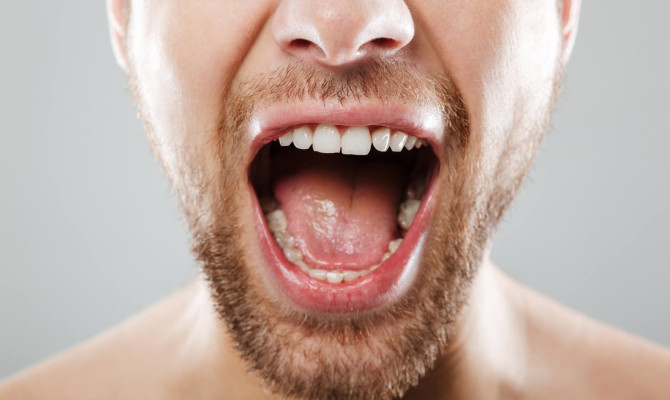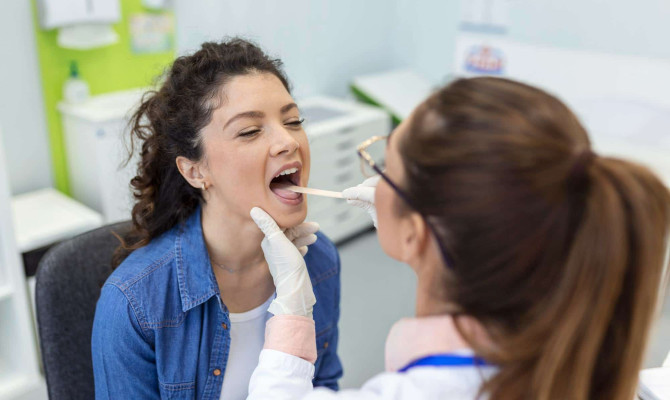Bruxism : Symptoms, Causes, and Management

- Bruxism
- 22 Aug 2023
Overview
What is bruxism?
Bruxism is a movement disorder in which someone unintentionally grinds or clenches their teeth. During the day, they may clench or grind their teeth or at night as they sleep. A person suffering from bruxism may be unaware of their condition. It can happen to anyone including children. However, because children’s jaws and teeth evolve quickly, they may outgrow bruxism as soon as they shed their milk teeth. This article discusses its symptoms, causes, risk factors, complications, and management.

Symptoms
Symptoms of bruxism
Bruxism symptoms and signs may include
- Abraded, missing, broken, or chipped teeth.
- Dentin is exposed by enamel wear.1Symptoms | Researched based study from Mayoclinic.org
- Teeth chewing surfaces flatten.
- Tense muscles in the face and jaw.
- Painful jaw or face or both.
- Temporomandibular joint (TMJ) clicking.
- Dull persistent headaches and ear pain.
- A locked jaw or a jaw dislocation.
- Damaged check on the inside, due to biting.
- Sleep deprivation.
Types
Types of bruxism
Bruxism can be of two different forms, namely
Awake bruxism (AB) or Diurnal bruxism (DB)
- It frequently involves a daytime clenching motion that is partially voluntary.2Types| Researched based study from Nlm.nih.gov
- AB is linked to life stress from familial responsibilities or professional strain.
- Treatment is often unnecessary if a person can recognize and stop.
Sleep bruxism (SB)
- Occurs during sleep, either during the day or at night.
- Bruxism during sleep was recently recognized as a sleeping-related movement condition.
- They could not get the support they need as they are unaware of what is going on.
- Another issue with this type is that people are unaware of how hard they clench or grind their jaw and teeth.
Causes
What are the causes of bruxism?
Bruxism has multiple reasons
- Tooth occlusion interference.
- Feelings of stress, rage, pain, or frustration.
- Neurotransmitter imbalance in the brain.2Causes | Researched based study from Nlm.nih.gov
- Antidepressant medications like paroxetine and fluoxetine.3Causes | Researched based study from Nlm.nih.gov
- Cigarette smoking.
Risk factors
Risk factors
The following variables may raise the chance of bruxism
- Genetic factor – Sleep bruxism is more common in families.
- Emotions – like increased worry, stress, anger, and frustration can increase the risk. 1Risk factors | Researched based study from Mayoclinic.org
- Certain personality types – like aggressiveness, competitiveness, or hyperactivity.
- Age–bruxism is prevalent in early childhood, although it typically goes away by the time they reach adulthood.
- Gender – occurs in both sexes. However, awake bruxism (AB) is more common among women.
- Smoking tobacco – cigarette smokers experience bruxism twice as often as nonsmokers. 2Risk factors | Researched based study from Nlm.nih.gov
- Caffeinated beverages and alcohol consumption may enhance the risk.
- Health conditions – like gastroesophageal reflux disease (GERD), Parkinson’s disease, attention-deficit or hyperactivity disorder (ADHD), epilepsy, dementia, and sleep-related disorders like sleep apnea 4Risk factors| Researched based study from Nlm.nih.govmay all raise the risk.
Diagnosis
Diagnosing bruxism
A dentist typically detects bruxism at a routine dental visit or when a patient visits them for another issue, such as tooth sensitivity or jaw pain.
Asking questions regarding general oral health, medications, daily routines, and sleep habits helps the dentist identify the reason for bruxism if they have a suspicion of it.
Physical examination
- Look for stiff jaw muscles.2Diagnosis | Researched based study from Nlm.nih.gov
- Temporomandibular joint (TMJ) pain.
- Watch out for TMJ clicking.
Oral examination – may show the following
- Teeth with flattened tips.
- A tooth’s filling that has broken.
- Missing or fractured teeth.
- Bite marks could be present inside the cheeks.
- A shaking tooth or teeth.
Observation and evaluation
- If a patient exhibits any symptoms of bruxism, the dentist observes changes in the mouth and teeth throughout the following appointments to evaluate whether the condition is progressing and whether treatment is necessary.
- To determine the severity of bruxism, taking a few dental and jaw X-rays may also be necessary.
- Dentists may suggest someone consult an expert in sleep medicine if their bruxism appears to be associated with significant sleep problems.
- If they suspect that someone’s anxiety or other psychological issues are related to their teeth grinding, they may also send them to a qualified therapist or counselor.
Complications
What are the associated complications?
Teeth grinding can result in the following problems
- Frequent headaches.
- Damage to the jaw, crowns, restorations, or teeth.
- Temporomandibular joint disorders (TMD).5Complications | Researched based study from Clevelandclinic.org
- Alterations to a person’s appearance.
- Teeth that are loose or broken.
- The deterioration of teeth.
- Eating disorders 6Complications | Researched based study from Medlineplus.gov
- A toothache.
- Depression.
Management
Management strategies of bruxism
Depending on the cause, the patient’s health, age, medical history, and preferences, the doctor may determine the appropriate course of treatment. In most circumstances, bruxism can be treated appropriately and may include
- Mouthguard or occlusal splints–are worn to guard against further tooth injury. It is a plastic appliance that patients can wear at nighttime to absorb the impact of chewing or throughout the day if the person grinds the teeth while awake.7Management | Researched based study from Nlm.nih.gov
- Dental corrections – are carried out by dentists on individuals who have poorly fitting dentures and subpar restorations.
- Behavior changes – once identified as bruxism, a person may be able to alter their habit by using the correct mouth and jaw positioning.
- Biofeedback –uses an electrical device to measure how much the jaw and mouth muscles move. It then alerts the person when their muscles are working too hard so they can take action to modify their habit. 8Management | Researched based study from Hopkinsmedicine.org
- Change of prescription – may be required if antidepressant medications are the source of bruxism.
- Medications – such as muscle relaxants, may aid in reducing jaw and neck tension. Some medications may aid neurotransmitter regulation. Severe cases may necessitate the use of Botox injections. 9Complications | Researched based study from Nlm.nih.gov
- Treating associated disorders – it may be possible to control bruxism by treating related conditions like GERD, Parkinson’s disease, dementia, anxiety, sleep apnea, and others.
Prevention

Preventing bruxism
To prevent bruxism at home, take the following actions
- Manage stress – doing yoga, mindfulness, taking a warm bath or shower, or taking a long stroll outdoors may help lower the risk.
- Get good sleep – it might be helpful. People with sleep issues should seek medical attention.
- Regular exercise improves sleep quality and maintains physical health.
- Avoid stimulants in the evening and at night, such as coffee, tea or other beverages that is caffeinated.
- Avoid smoking tobacco because it might raise the chances.
- Steer clear of alcohol in the late hours as it may exacerbate bruxism.
- Any daytime teeth grinding should be observed.
- Keep your lips together, your teeth spaced apart, and your tongue hidden behind your front teeth to try and stop yourself.
- Avoid biting or chewing nails, or other objects like pens, and pencils.
- Also, avoid chewing gum continuously and every day.5Prevention | Researched based study from Clevelandclinic.org
- If one needs assistance, joining online discussion forums or speaking with a trained therapist about their anxiety or anger problems may help.
- Get routine dental exams since the dentist can detect bruxism during regular examinations of the mouth and jaw.
Prognosis
Prognosis of bruxism
As bruxism is a complex disorder, a team of dentists, neurologists, pediatricians, mental health professionals, physiotherapists, and primary caregivers, should collaborate to manage the disease better and improve patients’ quality of life.
It is not a life-threatening condition, but it can harm teeth permanently and result in excruciating jaw pain, migraines, or ear problems.
Awake bruxism usually gets better if the person recognizes and stops it. Interventions typically do not cure nocturnal bruxism. With age, the conduct may become less severe. In a majority of patients, it frequently returns despite treatment.
Any feedback on this article?
 This Articles content was accurate
This Articles content was accurate Very Informative Article
Very Informative Article I have a question or a comment
I have a question or a comment
 This article contains inaccurate content
This article contains inaccurate content This article was not helpful
This article was not helpful I have a question or a comment
I have a question or a comment
We appreciate your helpful feedback!
Checkout our social pages
References
-
Mayo Clinic
Bruxism (teeth grinding) | Symptoms | Risk factors
-
National Library of Medicine
Bruxism: A Literature Review | Types | Causes | Risk factors | Diagnosis
-
National Library of Medicine
SSRI-associated bruxism | Causes
-
National Library of Medicine
The Relationship between Sleep Bruxism and Obstructive Sleep Apnea Based on Polysomnographic Findings | Risk factors
-
Cleveland Clinic
Bruxism (Teeth Grinding) | Complications | Prevention
-
Medlineplus
Bruxism | Complications
-
National Library of Medicine
Bruxism Management | Management
-
Johns Hopkins Medicine
Bruxism | Management
-
National Library of Medicine
Efficacy of botulinum toxin in the treatment of bruxism: Systematic review | Management






































